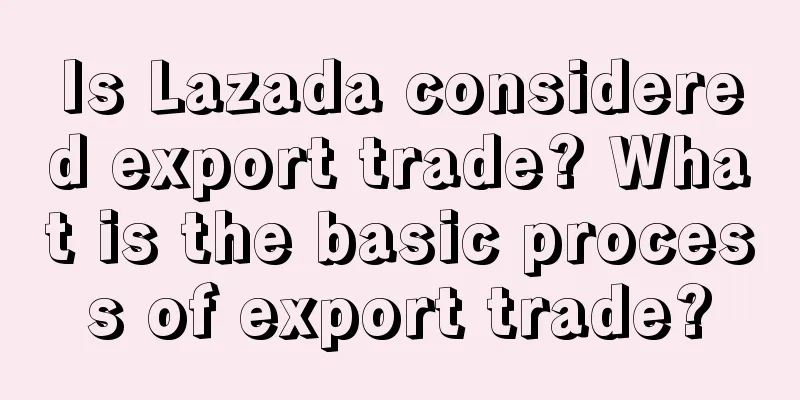Is Lazada considered export trade? What is the basic process of export trade?

|
As one of the largest e-commerce platforms in Southeast Asia, Lazada has attracted countless sellers and consumers, but the question is, is Lazada considered export trade? This article will explore the export trade potential and basic processes of the Lazada platform in depth to help sellers better understand the opportunities and challenges in this field. 1. Is Lazada considered export trade? Lazada is a Southeast Asian e-commerce company. It is an import company. 2. What is the basic process of export trade ? Export trade refers to the business activities of sellers selling goods or services outside the domestic market, usually involving cross-border trade. The basic process of export trade includes the following key steps: Market research: First, sellers need to conduct market research to understand potential export markets, including information such as target market demand, competition landscape, regulations and policies. Select export market: Based on the results of market research, sellers select target export markets. Lazada covers many countries in Southeast Asia, so it can be one of the export market options. Prepare goods and services: Sellers need to prepare goods and services that comply with the standards and regulations of the target market. This may include product improvements, labeling and packaging adjustments, etc. Find the right distribution channel: As an e-commerce platform, Lazada provides a wide range of distribution channels. Sellers can choose to open online stores on the platform to introduce goods and services to the target market. Ordering and logistics: Sellers need to establish an effective logistics and supply chain system to ensure that goods can be delivered to the target market on time. Lazada usually provides logistics cooperation and support to help simplify the logistics process. Marketing: Sellers need to conduct marketing on the Lazada platform, including product advertising, search engine optimization, social media promotion, etc. to attract potential customers. Customer Support: To build customer trust, sellers need to provide good customer support, answer customers’ questions and solve problems. Fulfill regulatory and tax obligations: Sellers need to comply with the regulations and tax provisions of their target markets to ensure they are operating legally. Managing Orders and Inventory: Sellers need to manage orders and inventory effectively to meet customer demand and avoid inventory overstocking. Collection and Settlement: Sellers need to ensure that the collection and settlement process goes smoothly in order to obtain sales revenue. Monitoring and Improvement: Finally, sellers need to constantly monitor sales and market feedback to make improvements and adjustments to achieve sustainable export trade. |
<<: How is it to be a seller on WishGo? How does Wish earn its commission?
Recommend
Will Amazon deliver during the Chinese New Year? What should I do if I cannot deliver?
Amazon is now preferred by many merchants because ...
The founder’s dilemma: personal IP takes a back seat, company brand takes a front seat
Compared with the company/brand IP, users often re...
Video account major category
This article will give you an in-depth understandi...
Does Amazon Mexico accept payments in US dollars? How do I receive payments?
Amazon's Mexican site is one of the North Amer...
With an investment of over 10 billion yuan, shelf e-commerce platforms are "fighting for the top of content"
This article deeply analyzes the strategic layout ...
How did this brand sell cotton for 4 billion by upgrading a cotton flower?
Want to improve your brand value? I think you need...
The collaboration with LV became popular, but Manner Coffee reached a fork in the road
Following the success of the joint venture between...
How to use social media to increase Amazon traffic? Method introduction
There are many ways to increase traffic to Amazon ...
Will the advertising industry still be good in 2023?
According to Buffett's concept of "corpor...
What are the big promotional activities in the second quarter of Wish?
The second quarter has begun! Wishmas is over, but...
How to attract customers when opening a new store? Here are five tips for opening a new store
If you want to attract customers when opening a ne...
How to get new traffic on Xiaohongshu as the precise crowd has reached the bottom? Unlock new crowds and new scenarios at low cost!
This article will analyze two typical cases - Garn...
When everyone understands that "free is the most expensive", operations go crazy
Giving away gifts and services to users for free i...
After reviewing the case in March, I have a new understanding of holiday marketing
This article shares new thoughts on festival marke...
Behind Decathlon's 10 billion annual sales: a differentiated strategy centered on experience
There is a brand that adopts an "experience-c...









